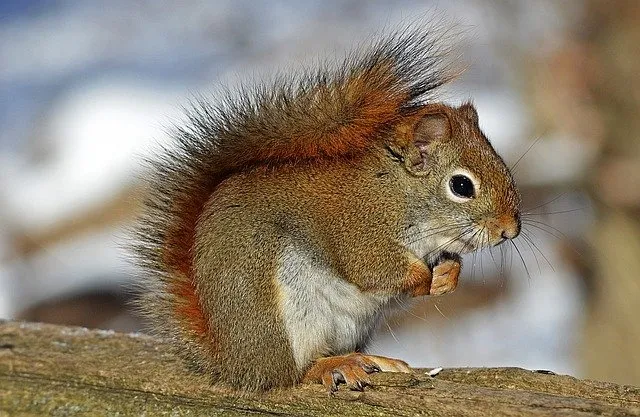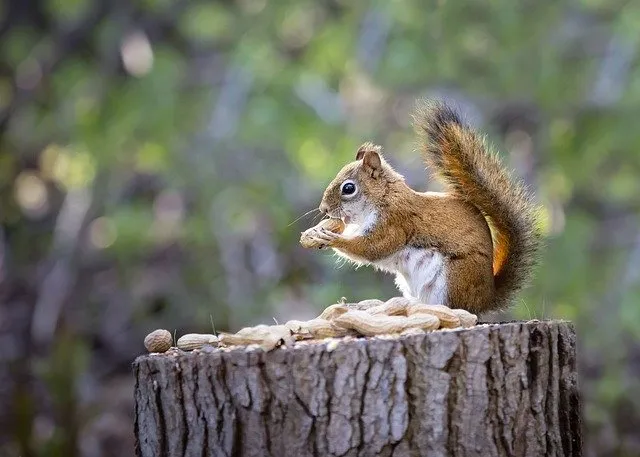As an Amazon Associate I earn from qualifying purchases.
In the heart of ancient woodlands, where the dappled sunlight dances through the emerald foliage, an adorable creature with fiery russet fur and an insatiable curiosity reign supreme. Meet the red squirrel, nature’s acrobatic marvel and culinary connoisseur extraordinaire. Enchanting all who witness their playful antics, these charming foragers lead a life shaped by their insatiable appetite for the finest gastronomic delights that Mother Nature has to offer. But what do red squirrels eat?
Embark on a captivating journey as we peel back the mystery surrounding the red squirrel’s dietary preferences, unraveling the secrets of their palate and exploring the diverse delicacies that sustain their adventurous spirit. Get ready to delve into the wild world of these vibrant creatures, where nuts, seeds, fruits, fungi, and even insects intertwine to form the exquisite tapestry of a red squirrel’s diet.
What Do Red Squirrels Eat?
The enchanting world of red squirrels beckons us with their playful acrobatics and vibrant russet fur. As nature’s acrobats, these charismatic creatures rely on a diverse and nutritious diet to fuel their energetic lifestyles. Join us on a gastronomic journey into the depths of the red squirrel’s diet as we unveil the delightful delicacies that keep them thriving in their wooded wonderland.
1. Nuts – Nature’s Treasure Trove:
Perhaps the most iconic image of a red squirrel involves them clenching a nut in their tiny paws. These fluffy foragers have a penchant for nuts, especially hazelnuts, beech nuts, and chestnuts. Red squirrels expertly crack open the tough outer shell with sharp incisors to reveal the delicious kernels. These nutrient-rich nuggets are a delicious treat and an essential source of protein, fats, and minerals.
2. Seeds – A Bounty of Nutrition:
In addition to nuts, red squirrels feast on an array of seeds that adorn their woodland habitat. From pine cones to sunflower seeds, they are masterful at extracting the seeds from their protective casings. The abundance of seeds gives them much-needed energy reserves during colder months when food is scarce. These protein-packed powerhouses ensure the red squirrels remain agile and active throughout the year.
3. Fruits – A Splash of Color and Flavor:
As omnivores, red squirrels also indulge in various fruits that dot their verdant playground. Juicy berries are among their fruity favorites, such as strawberries, blackberries, and blueberries. Besides being a delectable delight, fruits are an excellent source of essential vitamins and antioxidants, bolstering their overall health and immune system.
4. Fungi – Nature’s Hidden Gems:
Red squirrels are skilled at collecting fruits and nuts and have a keen interest in fungi. From mushrooms to truffles, these fungi forays add a touch of diversity to their diet. Fungi provide a unique blend of nutrients, including vitamins, minerals, and amino acids, making them an integral part of the red squirrel’s culinary repertoire.
5. Insects – The Protein Powerhouse:
Although they primarily rely on plant-based foods, red squirrels aren’t opposed to a protein boost occasionally. Insects, such as caterpillars, grasshoppers, and beetle larvae, offer a rich source of protein, crucial for developing and maintaining their muscle mass. These agile climbers demonstrate adaptability by capturing these tiny creatures during their foraging escapades.
Should I Keep Red Squirrels As A Pet?
For several reasons, keeping a red squirrel as a pet is generally not recommended. Red squirrels are wild animals that have evolved to thrive in their natural environment, and attempting to keep them as pets can lead to various issues, both for the squirrel and the owner.
1. Legal Issues:
In many places, it is illegal to keep native wildlife, including red squirrels, as pets. Wildlife protection laws exist to safeguard these animals and their ecosystems, and violating them can result in fines, penalties, or animal confiscation.
2. Ethical Concerns:
Red squirrels are wild animals with complex physical and behavioral needs. Keeping them captive can lead to stress, anxiety, and behavioral problems. They are highly active and agile creatures, requiring ample space and the ability to engage in natural behaviors like climbing, jumping, and foraging.
3. Zoonotic Diseases:
Wild animals, including red squirrels, can carry various zoonotic diseases that can be transmitted to humans. Living near a wild animal poses health risks, and not all diseases may be immediately apparent.
4. Diet and Nutrition:
Red squirrels have specific dietary requirements that may be challenging to meet in captivity. Providing a balanced diet that mimics their natural food sources can be difficult and may lead to health issues if not properly managed.
5. Social Isolation:
Red squirrels are social animals that typically live in communities. Keeping a single squirrel in captivity may lead to social isolation and loneliness, causing significant stress and unhappiness for the animal.
6. Lifespan and Commitment:
Red squirrels can live for several years in the wild, but their lifespan may be significantly shortened in captivity due to stress and inadequate care. Owning a pet squirrel requires a long-term commitment and specialized knowledge to ensure their well-being.
How Do Red Squirrels Help Our Ecosystem?
It is crucial to understand that the presence of red squirrels is vital to maintain the equilibrium and well-being of their respective ecosystems. It is crucial to understand that the presence of red squirrels is vital to maintain the equilibrium and well-being of their respective ecosystems. As native species, they have evolved to have specific ecological roles that contribute to the overall functioning of the ecosystem. Here are some ways in which red squirrels help our ecosystems:
1. Seed Dispersal:
Red squirrels are voracious seed eaters, especially skilled at caching seeds and nuts for future consumption. In their quest to hoard food, they often forget or fail to retrieve some of their buried caches, inadvertently aiding in seed dispersal. These forgotten caches can sprout into new trees and plants, contributing to forest regeneration and maintaining plant diversity.
2. Forest Regeneration:
The act of seed caching by red squirrels helps in the dispersal tree seeds across the landscape. This activity plays a crucial role in forest regeneration, allowing new trees to grow in different areas and ensuring the continuity of forest ecosystems.
3. Controlling Insect Populations:
While red squirrels primarily rely on a plant-based diet, they occasionally eat insects and insect larvae. By doing so, they help control insect populations, which can be beneficial for maintaining the health of trees and other vegetation.
4. Predator-Prey Relationships:
Red squirrels are an important prey species for various predators, including birds of prey, foxes, and other carnivores. Their presence in the food web helps support the populations of these predators, maintaining a balanced predator-prey relationship.
5. Fungi Spreading:
Red squirrels are known to cache and store fungi as well. In their caching behavior, they inadvertently help spread fungi spores, promoting the ecosystem’s growth and dispersal of various fungal species.
6. Indicator Species:
Red squirrels serve as indicator species, reflecting their habitats’ overall health and condition. A thriving red squirrel population indicates a healthy ecosystem with abundant food resources and suitable habitat.
7. Nutrient Cycling:
When red squirrels consume seeds, nuts, and plants, they play a role in nutrient cycling. Through their activities, nutrients are transferred from one part of the ecosystem to another, supporting the growth and health of various organisms.
Final Words
In conclusion, red squirrels are not just adorable creatures that captivate us with their playful charm; they are essential players in the intricate symphony of nature. Their unique ecological roles, from seed dispersal to forest regeneration, insect control, and nutrient cycling, contribute significantly to their ecosystems’ overall health and balance. While it is tempting to interact closely with these delightful creatures, it is crucial to remember that they are wild animals best appreciated from a respectful distance.
You can also read:
1.What Do Purple Martins Eat? A Gourmet Guide to Their Diet
2.What Do Puffins Eat? A Culinary Adventure
3.WHAT DO PRAIRIE DOGS EAT? A DELECTABLE GASTRONOMIC ADVENTURE
4.The Fascinating World of Oriol Diets: What Do Orioles Eat?
Amazon and the Amazon logo are trademarks of Amazon.com, Inc, or its affiliates.



